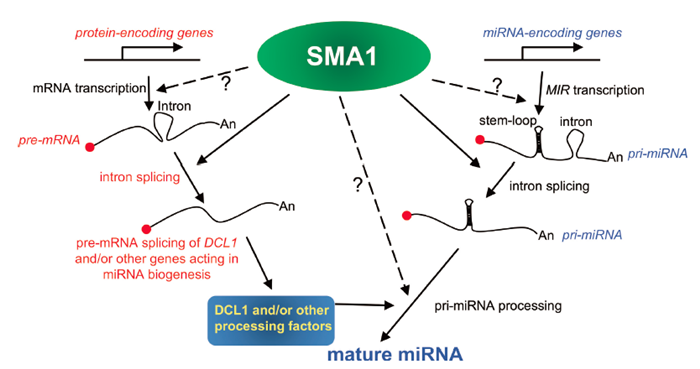SMA1 Gene May Bolster Crop Improvement
The growth, development, and yield of plants are greatly affected by various biotic and abiotic stresses, such as bacteria, fungi, pests, drought, salt, and temperature stresses. Plants need to tightly control the developmental progress and stress responses through regulating gene express levels.
microRNA (miRNAs) are a class of regulatory RNAs (Ribonucleic Acid) with the small size about 21 nucleotide. They target their specific mRNAs via the complementary sequences for degradation or translational inhibition. However, the mechanisms on how miRNA abundance is controlled are largely unknown in plants.
Recently, researchers from a collaborative team of Dr. LI Shengjun’s group at Qingdao Institute of Bioenergy and Bioprocess Technology (QIBEBT), Chinese Academy of Sciences (CAS), and Dr. LI Yunhai’s group at Institute of Genetics and Developmental Biology, CAS, and Dr. YU Bin’s group at University of Nebraska-Lincoln identified the function of SMA1 gene in plant miRNA generation.
They found that SMA1 gene encodes a DEAD-box protein and plays a multifaceted role in the processes of miRNA processing: (1) interacts with DCL1 complex to promote pri-miRNA processing; (2) directly interacts with MIR promoter regions; (3) influences DCL1 protein level via regulating intron alternative splicing of DCL1 pre-mRNA. The findings suggested SMA1 may be important to fine-tune microRNA levels to keep plant healthy.
“Because the loss-of-function mutation of SMA1 leads embryo lethal in plants, SMA1 gene function remains unknown in plants. This work isolated a weak allele with a hypomorphic mutation and will facilitate the functional study of SMA1 gene,” said Dr. LI Shengjun. “The study on how plants control miRNA amounts is very important to improve crops.”
Their findings entitled “SMA1, a homolog of the splicing factor Prp28, has a multifaceted role in miRNA biogenesis in Arabidopsis” were recently published in Nucleic Acids Research.
This work was financially supported by grants from the National Natural Science Foundation of China, Ministry of Agriculture of China, Strategic Priority Research Program “Molecular Mechanism of Plant Growth and Development”, Nebraska Soybean Board, and National Science Foundation of US.

Figure: The working model of SMA1 regulatory roles. (Image by LI Shengjun)
(Text by LI Shengjun)
Contact:
Tel: 86-532-80662647
E-mail: chengjing@qibebt.ac.cn